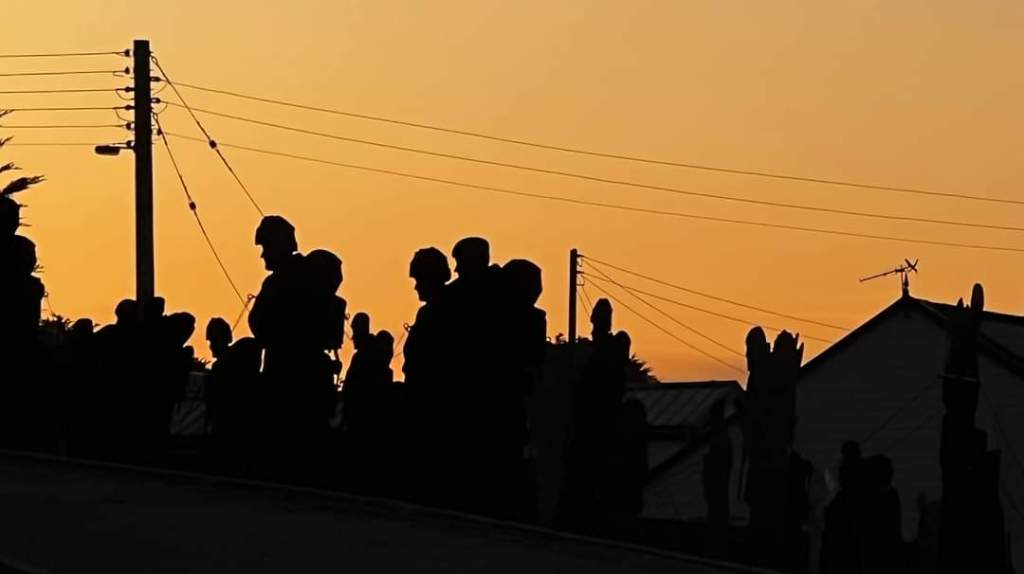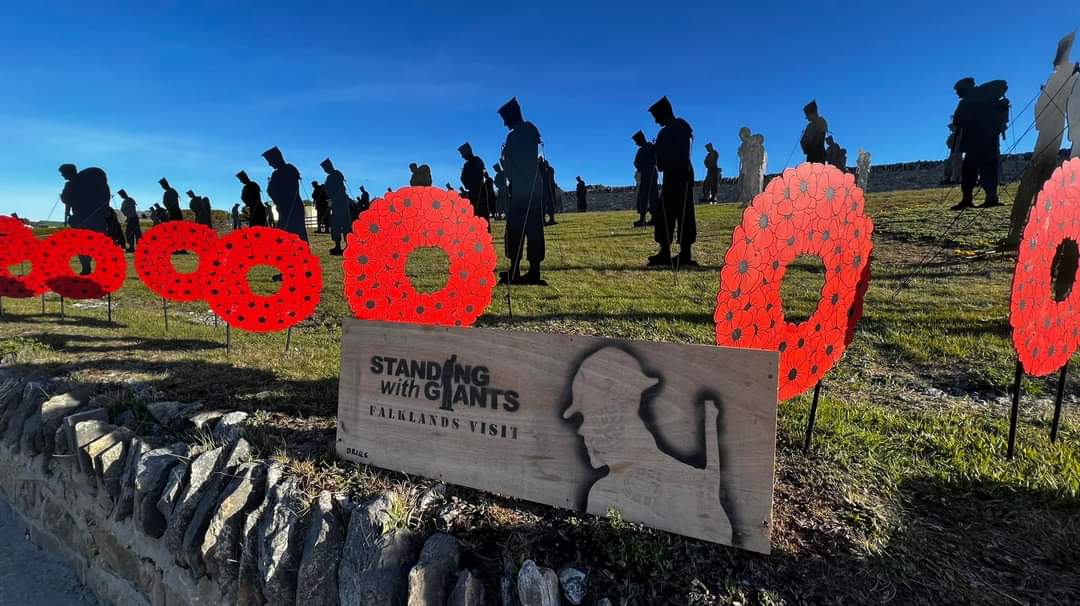Last Saturday was pure sunbathing weather. I mention this because a) I’m writing from the Falkland Islands, where such occurrences are not exactly regular, and b) I spent the whole beautiful day, with two or three dozen other volunteers, drilling through rock to stake out a couple of hundred 6ft metal figures. I even had to wear a hat.
This wasn’t the first time I’d attempted such a challenge. I lent a hand twice last year – first when we put up 100 Tommy silhouettes commemorating the centenary of the Royal British Legion. In the main these were set out on the sloping banks around the Stanley Cemetery and its first and second world war Cross of Sacrifice.
As with all inaugural events, lessons were learned – namely that the cemetery was founded on a hill made out of concrete. The lightweight 2D cut-outs – modified specifically for near-gale South Atlantic-type conditions, with guy ropes, rebar stake and 18in spikes descending from their feet – could not simply be stabbed into the ground by hand. Or even with the vigorous application of a boot. Drills were required – with 3ft drill bits. And a generator.
Aside from unboxing, laying out, disentangling of guy ropes, drilling and hammering, it soon became clear we would also have to clean and paint the silhouettes
The terra may have been a little less firma by mid-winter, when my second attempt came around – but by then there were 258 figures to put up in a peaty paddock by the entrance road to Stanley. A more Falklands-specific commemoration, these came in five patterns: 255 soldiers, marines, sailors and airmen – one for each of those UK servicemen who died fighting the Argentinians in 1982 – and three female silhouettes, for the civilians who were killed in the accidental (royal) naval shelling of a house in town.
Now the project’s come full circle (well, full triangle), with the 258 erected once again around the Cross of Sacrifice for this week’s Remembrance parade. This is pertinent as there are a lot of 1982 veterans in town this Remembrancetide, many having been prevented from attending the 40th anniversary liberation celebrations in June thanks to the islands’ Covid policies and RAF-based transport problems.
The silhouettes themselves are made – handmade – by Standing with Giants, an Oxfordshire community project set up three years ago by Dan Barton. Despite working only in their spare time and using recycled road signs for their raw materials, Dan and his band of local volunteers have created an impressive number of large-scale art installations, to some considerable effect (as you will see if you go to their Instagram account). This year, the Stanley figures form just a proportion of more than 1,000 Forces silhouettes on display, with others at Hampton Court Palace, Lord Rothschild’s Waddesdon Manor and the International Bomber Commander Centre in Lincolnshire.
Needless to say, the team on the ground in the Falklands were all volunteers as well – including those from the British Forces South Atlantic Islands base at Mount Pleasant Complex, members of the local branch of the RBL and civilian helpers from the topmost echelons of Stanley society. The Falkland Islands Government Office staff in London had visited the SWG workshop some months back for a day’s painting; a local fishing company facilitated storage; and a Stanley haulier supplied logistics.

The chap in charge at this end was Chris Locke, formerly of the Merchant Navy (an ’82 veteran, no less), onetime harbour master of both Mare Harbour (the military port) and Stanley, and recent Commonwealth Games athlete for the Falkland Islands. Not entirely coincidentally, he’s also the chairman of the Stanley RBL branch. But then the Falklands is that kind of place.
Last year I met Steve, erstwhile military police dog handler, ship’s captain and now member of the government of South Georgia and the South Sandwich Islands (try saying that fast at a gin-fuelled drinks party). Then there was Derek, a retired FIGAS (local air service) pilot and officer in the Falklands Islands Defence Force; Sorrel, a conservationist (also FIDF); Malcolm, the Scottish dentist who’d been here a week at most; Mark, a trainee carpenter with a PhD in psychiatry and his own canoeing company, and his wife Charlie, from the Falkland Islands government environmental policy unit (both FIDF); the then-headmaster of the secondary school and a smattering of his staff; and Tony, the BFSAI Garrison Sergeant Major, with about a dozen ‘volunteers’ from MPC.
This year, I had the company of Becky, recently-arrived director of development and commercial services for FIG; Rob, the manager of the new port project; Beccy, a fellow member of the FIDF who works in the tax office; Chris’s wife Nancy, impresario of the Falkland Islands Operatic and Dramatic Association and chair of the Public Accounts Committee; Heather, the (new) dentist, who spent the first half-hour of her day ‘off’ on the phone diagnosing someone out in Camp and prescribing goodies from their medicine cabinet; Andy, another FIDF officer (now retired) and leading light in cancer fundraising; Tim, a primary school teacher, pub-quiz master (and my host for tonight’s black-tie Poppy Ball); Traighana, my newsroom boss at Falklands Radio; and Wendy, one of my regular quiz contestants on the Breakfast Show, whom I’d hitherto known only as a disembodied voice (and vice versa).
Nth-generation Falkland Islanders were, it must be said, not over-represented; but this was compensated for by a second Bedford-ful of guys from MPC who’d clearly only just arrived in these latitudes, were conspicuously overdressed for the proceedings and had obviously been told there was a bus-ride going into Stanley… oh, and Tony, of course. The lads shot me some nervous looks when I addressed him thus.

Aside from all the unboxing, laying out, distributing of stakes, disentangling of guy ropes, drilling and hammering, it soon became clear we would also have to clean and paint the silhouettes, as the winter weather and subsequent storage had done a bit more damage than could be brushed off (literally) as simply ‘characterful’. This actually turned to be something of a blessing in disguise, as there’s only so much 30-odd of even the most enthusiastic volunteers can do with four or five hammers and three electric drills between them.
The sun continued to beat down, and as the day wore on, there were some pretty red faces – and arms, necks and backs of legs. When people began to flag, there was a break for cake… and then some rusty cans of Bud emerged… and then we threw ourselves upon the mercy of the Falkland Beerworks. By 4 p.m., though, we were all squared away, in time to wash up and head out to Moody Brook for Bonfire ‘Night’ – the only time I’ve seen a Guy Fawkes immolated in broad daylight.
But the Giants are up now: and, as the veterans and next of kin start to arrive, that’s all that matters. I’d be lying if I said I’m keen to put the whole lot up and down twice every year (the weather’s never going to be that good again); but – as the silhouettes are very much there to remind us – there are far grimmer ways to spend a day than wielding a paintbrush or a hammer in the sunshine.






Comments